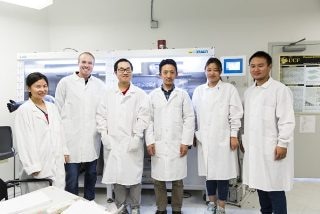Sep 20 2017
Assistant Professor Yang Yang’s research team at the University of Central Florida has developed two potential energy storage technologies in its work with sustainable energy systems.
 Researchers Zhao Li, Kyle Marcus, Kun Liang, Assistant Professor Yang Yang, Guanzhi Wang and Wenhan Niu are developing new energy technologies. Credit: University of Central Florida
Researchers Zhao Li, Kyle Marcus, Kun Liang, Assistant Professor Yang Yang, Guanzhi Wang and Wenhan Niu are developing new energy technologies. Credit: University of Central Florida
Yang sees revolutionary systems that can generate and store energy efficiently and inexpensively as a potential solution to environmental and energy crises.
“We try to convert solar energy either to electricity or chemical fuels. We also try to convert chemical fuels to electricity. So, we do different things, but all of them are related to energy,” said Yang, who came to UCF in 2015 and has joint appointments in the NanoScience Technology Center and the Department of Materials Science and Engineering.
One of the Researchers’ technologies would upgrade the lithium-based batteries that are ubiquitous in today’s electric vehicles, portable electronics, smartphones and laptops. The other provides a more stable and safer alternative than lithium batteries.
Electrode for High-Performance Battery
As reported recently in the scholarly journal Advanced Energy Materials, the UCF research team has designed an innovative type of electrode that is cost effective to manufacture, stable at high temperatures and shows exceptional conductivity. Most notably, it allows a high-performance lithium battery to be recharged a number of times without degrading.
Batteries produce electrical current when ions pass from the anode, or negative terminal, to the cathode, or positive terminal, through an electrolyte.
A battery cathode made from a thin-film alloy of iron sulfide and nickel sulfide was developed by Yang’s team. That combination of materials offers huge benefits to their new electrode.
On their own, both iron sulfide and nickel sulfide show good conductivity. Researchers found that the conductivity is even better when they are combined.
They were able to boost conductivity further by making the cathode from a thin film of nickel sulfide-iron sulfide, then etching it to produce a porous surface of microscopic nanostructures. These holey structures or nanopores expand the surface area available for chemical reaction to a great extent.
This is really transformative thin-film technology.
Assistant Professor Yang Yang, NanoScience Technology Center and the Department of Materials Science and Engineering, the University of Central Florida
Ultimately, all batteries begin degrading after they have been drained and recharged time and again. Quality lithium-based batteries can be drained and recharged about 300 to 500 times before they start to lose capacity. Tests confirm that a battery with the nickel sulfide-iron sulfide cathode could be depleted and recharged more than 5,000 times before degrading.
Researchers Kyle Marcus and Kun Liang from Yang’s group worked on the project. Other collaborators include Le Zhou, Yilun Li, Samuel T. De Oliveira, Nina Orlovskaya and Yong-Ho Sohn, all of UCF, and Shoufeng Zhang of Jilin University in China, and Yilun Li of Rice University.
New Catalyst for Better Energy Storage
Graduate Student Researchers in Yang’s lab also developed a new catalyst for a high-efficiency battery that has many advantages when compared to traditional ones.
Fuel cells, metal-air batteries and other energy storage and conversion applications depend on chemical reactions to generate current. Consequently, those reactions require an efficient catalyst to help them along. Precious metals including iridium, palladium, and platinum, have proven to be efficient catalysts, but their poor stability, durability and high cost make them unfeasible for large-scale commercialization.
Researchers in Yang’s team headed by Wenhan Niu, Zhao Li and Kyle Marcus developed a novel process for producing a catalyst with a substrate of graphene, an extremely conductive two-dimensional material with the thickness of a single atom.
As reported in Advanced Energy Materials last week, Researchers showed the effectiveness of their catalyst’s nanomesh-like structure by testing it in a zinc-air battery, indicating its ability of being depleted and recharged many times.
The electrocatalyst is more stable and safer than the volatile compounds found in lithium batteries, and can work in extreme temperatures, rain and other harsh conditions. It can be manufactured more economically without the need for precious metals.
Besides Marcus, Yang, Li and Niu the research team included Kun Liang and Le Zhou of UCF, as well as Ruquan Ye and Yilun Li of Rice University.